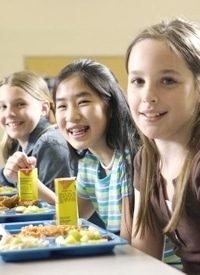
With the federal deficit edging towards $15 trillion, one wonders where federal officials found $2 million to fund a research project in Texas that will photograph students’ lunch trays before they sit down to eat and later photograph the leftovers. According to The Blaze, the computer program that takes the photographs “analyzes the photos to identify every piece of food on the plate — right down to how many ounces are left in that lump of mash potatoes —and calculates the number of calories each student scarfed down.”
The details of the program are as follows:
Each lunch tray gets a bar code sticker to identify a student. After the children load up their plates down the line — cole slaw or green beans? french fries or fruit? — a camera above the cashier takes a picture of each tray.
When lunch is over and the plates are returned to the kitchen, another camera takes a snapshot of what’s left. Echon’s program then analyzes the before and after photos to calculate calories consumed and the values of 128 other nutrients. It identifies foods by measuring size, shape, color and density.
Parents will receive the data for their children, and researchers hope eating habits at home will change once moms and dads see what their kids are choosing in school. The data also will be used to study what foods children are likely to choose and how much they’re eating.
The project is being funded by a grant by the United States Department of Agriculture and is the first of its kind in the nation, as there is no food-recognition software. The San Antonio school cafeteria includes small cameras that allegedly point only to the trays and does not photograph the students. Approximately 90 percent of parents at the San Antonio school have already given their permission for the computer program to record their child’s eating habits.
Dr. Roger Echon of the San Atonio-based Social & Health Research Center and builder of the computer program explains, “We’re trying to be as passive as possible. The kids know they’re being monitored.” Echon added that he felt the program was necessary as children are often forgetful of what they ate throughout the course of a day and can hardly be expected to remember to record it themselves.
The project is not entirely complete, however, as Echon is still in the process of developing the program and plans to spend the first year of the four-year grant adjusting the equipment. By the school year 2012–2014, the Social Health & Research Center hopes to have a prototype in place.
The computer program already accounts for consistencies and textures of foods, and includes 7,500 different varieties of food.
Researchers chose poor, minority schools where obesity rates tend to be higher as the pilot schools for the program. For example, five schools in Bexar County were selected as pilot schools since 33 percent of those children live in poverty and are obese. Researcher are careful to point out, however, that obesity is not necessarily tied to calorie intake, as nearly 44 percent of the children studied have been below the daily minimum caloric intake, but nearly one third of those children were still obese.
The computer program seems to be in line with the nanny state that is slowly but surely taking hold in the United States. Days ago, The New American reported that school districts are currently considering banning flavored milk from cafeteria menus in an effort to target obesity. Unfortunately, data reveals that the absence of flavored milk from school menus decreases milk consumption by 30 percent, a fact that officials seem to have ignored.
Last year, the Department of Agriculture gave $2 million to food behavior scientists so that they may engineer and utilize marketing techniques to trick students into choosing healthier food options. The money was used to fund 14 research projects in Connecticut, Iowa, Louisiana, Minnesota, Oklahoma, Pennsylvania, South Carolina, Texas, Utah, West Virginia, and Wisconsin.
The DOA justified the funding of such a project in a statement that read:
It is well recognized that understanding the value of a healthy diet does not always translate into healthy choices. Research has shown that good intentions may not be enough: when choosing what or how much to eat, we may be unconsciously influenced by how offers are framed, by various incentives, and by such factors as visual cues.
It also declared that the research “can suggest practical, cost-effective ways that the school environment can better support healthful choices.”
One wonders if the new computer project in San Antonio is one of the “practical, cost-effective” methods recommended by the food behavior psychologists.




